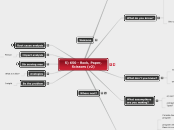5) 650 - Rock, Paper, Scissors (v2)
Problem type
Problem type
What do you know?
Fact
Use case(s)
Primary
Revised
1) Splash/Welcome
a) Display name of the
program and a nice hello
2) Input
a) prompt player for choice
b) get player's choice
3) Process
a) obtain computer's choice
b) compare player and computer
choices => results
4) Output
a) display computer choice
b) display results
5) END PROGRAM
a) display a "pause"
message before exiting
What don't you know?
randomize computer choice
enumerating the available:
choices
results
What assumptions
are you making?
a) user knows how to play RPS
computer can generate a
"good" random number
Solution criteria
Console-based
program
program will loop until
there is a winner
validate player/user input
conditional logic is limited
to 'if/else if/else'
looping is limited to 'while'
no user-defined functions
use const int's to represent
possible choices and outcomes
Root cause analysis
Impact analysis
Person
Impact
Six serving men
Analogies
What is it like?
Be the problem
Insight
